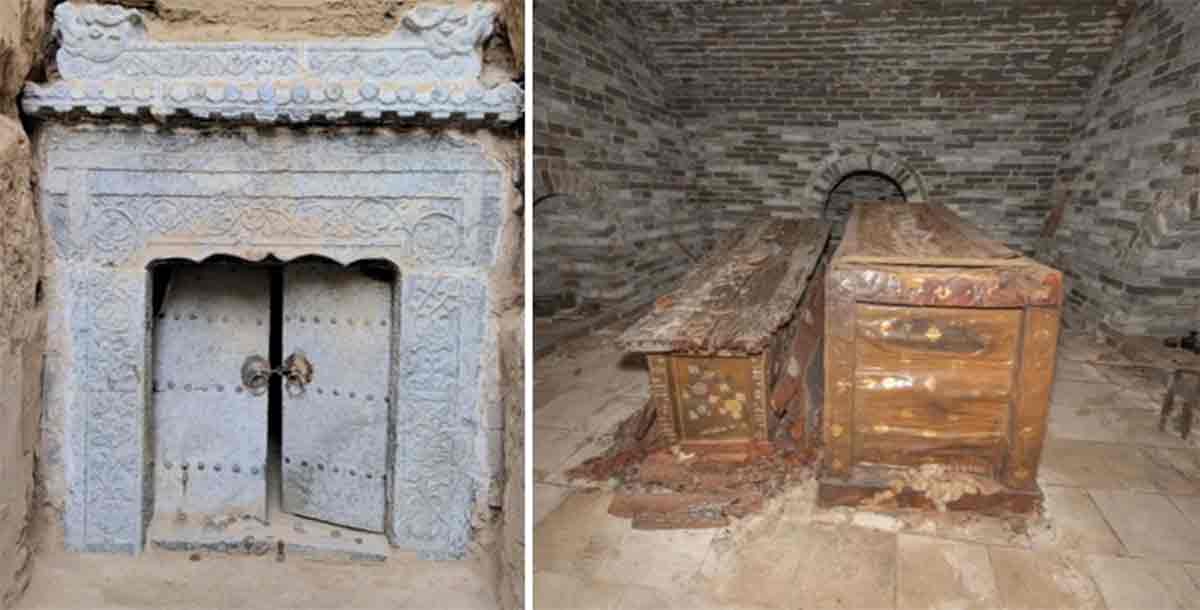Pristine Ming Dynasty Tomb Unearthed in China’s Shanxi Province
For centuries, the pale blue doors of a formidable stone Ming Dynasty tomb in China’s Shanxi Province have remained tightly shut, shrouded in mystery. Upon gaining entry, archaeologists were greeted by a scene of unparalleled grandeur and sophistication – a 400-year-old stone-brick tomb dating back to the Ming Dynasty (1368-1644), in immaculate condition and elegantly crafted!
The Shanxi Provincial Institute of Archaeology revealed that ahead of highway construction, they’d embarked on the excavation of this ancient stone tomb located in Xinfu District, which lies approximately 300 miles southwest of Beijing. They diligently explored sites spanning various historical periods, including the Longshan Period (2900-2100 BC), the Warring States Period (475-221 BC), and unearthed a total of 66 tombs from different dynasties.
- 2,200-year-old Tomb Packed With Artifacts and History Unearthed in China
- Experts Blown Away by Ancient Tactical Defense Tunnels Unearthed in China
Entombed in Elegance: Royalty Galore
The pick of the lot was a brick-tomb located on the western terrace of Hexitou village. Comprising a sloping passageway 17 meters (55.7 ft) long, a central burial chamber, and a smaller rear chamber, the tomb stretched about 25.3 meters (83ft) in length. A striking image captured the tomb's sealed entrance, adorned with a stone gatehouse and a set of imposing double doors.
Within the main burial chamber, archaeologists encountered two beautifully adorned wooden coffins with intricate motifs, and two niches: one in the south containing four porcelain jars, and the other in the north containing five porcelain jars and four porcelain bottles.
- Most Shocking Things Found Inside Ancient Tombs (Video)
- Archaeologists unearth spectacular textiles in Ming Dynasty Tomb

Intricately adorned coffins, depict the grandeur and legacy of a bygone era. (Shanxi Provincial Institute of Archaeology)
These motifs include gold diamonds, leaves, and other miscellaneous designs featuring side panels adorned with depictions of birds, specifically peacocks, along with flourishing trees and floral motifs. The chamber housed several pottery jars that could have contained grains, oils, and other substances.

Designs feature side panels adorned with depictions of birds, specifically peacocks. (Shanxi Provincial Institute of Archaeology)
An epitaph inscribed in seal script, offers a clue to the possible identity of the deceased: “Epitaph of the Prince of Ming Ru Hou’an,” hinting at a noble lineage and prestigious title. Adding to the general mystery is a carved portal surrounding the entrance, fashioned in a manner to resemble a wooden gate tower. The design features a delicate floral pattern around the structure, crowned by a roof ridge, and embellished with two outward-facing depictions of dragons.
The second coffin, distinguished by a diamond-shaped pattern, bears an inscription in regular script. The inscription reads: “Ming Gu Rong Kao Hou Ru Wang Gong”, translating to "Entrusted by the Ming Dynasty to serve the royal court as a palace official.” Clearly, the deceased here was a member or an official of the royal court, and likely to have been close to the imperial dynasty, reports The Heritage Daily.
The final chamber at the rear of the tomb revealed a collection of wooden furniture, including altars, tables, and chairs, although much of it lay in a state of collapse and disrepair, as depicted in photographs provided by the institute. Among the discoveries in the rear chamber were writing implements such as inkstones, Chinese calligraphy brush pens, and pen holders, as reported by China Daily, a state-controlled news outlet.
Inscriptions found on the coffins and walls provided valuable clues, allowing researchers to identify the deceased as a man who lived between 1533 and 1588, according to the institute. Given the high caliber of artifacts and the exceptional state of preservation, archaeologists deemed the tomb to be of rare significance and clearly belonging to someone of an exalted status.

Wooden burial objects and sacrificial items were well-preserved. (Shanxi Provincial Institute of Archaeology)
The Ming Dynasty: Rise and Fall of a Medieval Asian Power
The Ming Dynasty, which reigned over China from 1368 to 1644, marked a significant period in the country's history. Rising to power after the Mongol Yuan Dynasty, the Ming Dynasty’s reign saw an unprecedented rise in China’s population and prosperity, explains World History Encyclopedia.
One of the most enduring legacies of the Ming Dynasty is the construction of the Forbidden City, the majestic imperial residence located in Beijing. The Ming era witnessed a flourishing of literature and the arts - poetry, painting, calligraphy, and other cultural pursuits. This period saw the emergence of renowned literary figures and artistic masterpieces that continue to influence Chinese culture to this day.

Among the pottery artifacts discovered in the chamber of the Ming Dynasty tomb. (Shanxi Provincial Institute of Archaeology)
Another enduring legacy of the Ming Dynasty is the production of exquisite blue-and-white porcelain, known as Ming porcelain. Renowned for its delicate craftsmanship and intricate designs, Ming porcelain remains highly prized by collectors and enthusiasts worldwide.
Despite these achievements, the Ming Dynasty faced persistent challenges that ultimately led to its downfall. Internal strife, factionalism within the court, rampant corruption, and extravagant spending drained the empire's resources and weakened its governance. Moreover, discontent among the peasantry fueled numerous rebellions, exacerbating the dynasty's internal instability. Unable to effectively address these issues, the Ming Dynasty succumbed to the invasion of the Manchus, who established the Qing Dynasty in 1644.
Top image: A Ming Dynasty tomb, remarkably preserved, was discovered in Xinzhou city, located in Shanxi province. Source: Shanxi Provincial Institute of Archaeology
By Sahir Pandey
References
Cartwright, Mark, 20. Ming Dynasty. World History Encyclopedia. Available at: https://www.worldhistory.org/Ming_Dynasty/
Huiyung, Z. 2024. Well-preserved Ming Dynasty tomb unearthed in Shanxi. Available at: https://www.chinadaily.com.cn/a/202403/12/WS65efbd32a31082fc043bc1f5_1.html.
Milligan, M. 2024. Intact monumental Ming Dynasty tomb found in China’s Xinfu District. Available at: https://www.heritagedaily.com/2024/03/intact-monumental-ming-dynasty-tomb-found-in-chinas-xinfu-district/151018.
Yan, L. 2024. Well-preserved Ming Dynasty tomb unearthed in Shanxi. Available at: https://www.ecns.cn/news/2024-03-12/detail-ihcyptyk0572460.shtml.

















